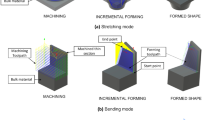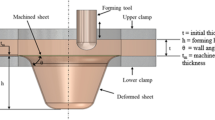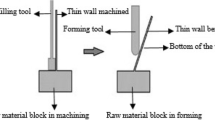Abstract
Deformation machining (DM) provides combined advantages of machining and Incremental sheet forming (ISF) processes to shape a monolithic component on a single setup to provide a high degree of flexibility. The authors propose DM as a rapid manufacturing solution, as an alternative to conventional methods for the fabrication of customized products at the development stage. The work presents the experimental results of the capabilities of the DM (bending mode) to produce impeller blade-like structures. To simulate the conditions for the blades of an impeller, a block of aluminum alloy AA6061-T6 is machined to create thin-walled preforms for blades, which are fixed at the base (at the bottom) and the core (at the side). Later, these preforms are shaped into the final configuration using ISF operation. This paper discusses the tool path development and forming strategies. The feature extraction approach is used to develop tool paths for impeller blade-like structures with varying blade angles. The forming forces, geometric accuracy, and surface roughness are the response parameters considered for the assessment of the formed blades. The results obtained show that the resultant forces increase with the blade angle. The forming methodology and tool path strategies are responsible for the geometric accuracy of the desired product. Also, the higher stiffness of the blades of 2 mm thickness shows higher springback, thus, the angular deviations are higher in comparison with the blades of 1 mm thickness. This research provides an idea of the formability of the material in the case of the bending mode of DM to bend the thin blade structures with fixed-fixed-free-free boundary conditions to produce monolithic components having complex geometry.






















Similar content being viewed by others
Availability of data and materials
Not applicable.
Code availability
Not applicable.
References
Kumar P, Priyadarshi S, Tandon P (2021) Investigating the incremental forming capabilities of extra deep drawn steel: proc IMechE Part C: J Mechanical Engineering. Science. https://doi.org/10.1177/09544062211027201
Shrivastava P, Kumar P, Tandon P, Pesin A (2018) Improvement in formability and geometrical accuracy of incrementally formed AA1050 sheets by microstructure and texture reformation through preheating, and their FEA and experimental validation. J Braz Soc Mech Sci Eng 40:1–15. https://doi.org/10.1007/S40430-018-1255-9/FIGURES/12
Mandaloi G, Nagargoje A, Gupta AK et al (2022) A comprehensive review on experimental conditions, strategies, performance, and applications of incremental forming for deformation machining. J Manuf Sci Eng 144:110802. https://doi.org/10.1115/1.4054683
Smith S, Woody B, Ziegert J, Huang Y (2007) Deformation machining-a new hybrid process. CIRP Ann Manuf Technol 56:281–284. https://doi.org/10.1016/j.cirp.2007.05.065
Singh A, Agrawal A (2018) Investigation of parametric effects on geometrical inaccuracies in deformation machining process. J Manuf Sci E T ASME 140:1–8. https://doi.org/10.1115/1.4039586
Li Y, Chen X, Liu Z et al (2017) A review on the recent development of incremental sheet-forming process. Int J Adv Manuf Technol 92:2439–2462. https://doi.org/10.1007/s00170-017-0251-z
Nagargoje A, Kankar PK, Jain PK, Tandon P (2021) Application of artificial intelligence techniques in incremental forming: a state-of-the-art review. J Intell Manuf. https://doi.org/10.1007/s10845-021-01868-y
Wu S, Ma Y, Gao L et al (2020) A novel multi-step strategy of single point incremental forming for high wall angle shape. J Manuf Process 56:697–706. https://doi.org/10.1016/j.jmapro.2020.05.009
Gupta AK, Shahare H, Kumar P et al (2022) Effect of tool path strategy and tooltip profile on geometrical feature and surface quality of Al-6061 alloy during deformation machining in bending mode. Adv Mater Process Technol. https://doi.org/10.1080/2374068X.2022.2091835
Zhang R, Shao Z, Lin J (2018) A review on modelling techniques for formability prediction of sheet metal forming. Int J Lightweight Mater Manuf 1:115–125. https://doi.org/10.1016/j.ijlmm.2018.06.003
Lu H, Liu H, Wang C (2019) Review on strategies for geometric accuracy improvement in incremental sheet forming. Int J Adv Manuf Technol 102:3381–3417
McAnulty T, Jeswiet J, Doolan M (2017) Formability in single point incremental forming: a comparative analysis of the state of the art. CIRP J Manuf Sci Technol 16:43–54. https://doi.org/10.1016/j.cirpj.2016.07.003
Ai S, Long H (2019) A review on material fracture mechanism in incremental sheet forming. Int J Adv Manuf Technol 104:33–61. https://doi.org/10.1007/s00170-019-03682-6
Lu B, Chen J, Ou H, Cao J (2013) Feature-based tool path generation approach for incremental sheet forming process. J Mater Process Technol 213:1221–1233. https://doi.org/10.1016/j.jmatprotec.2013.01.023
Nagargoje A, Kankar PK, Jain PK, Tandon P (2021) Performance evaluation of the data clustering techniques and cluster validity indices for efficient toolpath development for incremental sheet forming. J Comput Inf Sci Eng 21:1–11. https://doi.org/10.1115/1.4048914
Singh A, Agrawal A (2016) Comparison of deforming forces, residual stresses and geometrical accuracy of deformation machining with conventional bending and forming. J Mater Process Technol 234:259–271. https://doi.org/10.1016/j.jmatprotec.2016.03.032
Singh A, Agrawal A (2015) Investigation of surface residual stress distribution in deformation machining process for aluminum alloy. J Mater Process Technol 225:195–202. https://doi.org/10.1016/J.JMATPROTEC.2015.05.025
Singh A, Agrawal A (2015) Experimental investigation on elastic spring back in deformation machining bending mode. In: Proceedings of the ASME 2015 International Manufacturing Science and Engineering Conference MSEC2015. pp 1–8
Lu H, Li Y, Liu Z et al (2014) Study on step depth for part accuracy improvement in incremental sheet forming process. Adv Mater Res 939:274–280. https://doi.org/10.4028/www.scientific.net/AMR.939.274
Li ZL, Zhu LM (2019) Compensation of deformation errors in five-axis flank milling of thin-walled parts via tool path optimization. Precis Eng 55:77–87. https://doi.org/10.1016/j.precisioneng.2018.08.010
de Souza AF, Käsemodel RB, Arias M et al (2019) Study of tool paths calculated by different commercial CAM systems and influences on the real machining time and surface roughness for milling free-form geometries. J Braz Soc Mech Sci Eng 41:1–12. https://doi.org/10.1007/s40430-019-1865-x
Naghdi Sedeh MR, Ghaei A (2021) The effects of machining residual stresses on springback in deformation machining bending mode. Int J Adv Manuf Technol 114:1087–1098. https://doi.org/10.1007/s00170-021-06816-x
Ju Y, Zhang C (2016) Robust design optimization method for centrifugal impellers under surface roughness uncertainties due to blade fouling. Chin J Mech Eng (Engl Edn) 29:301–314. https://doi.org/10.3901/CJME.2015.1222.153
Zariatin DL, Rahmalina D, Prasetyo E et al (2019) The effect of surface roughness of the impeller to the performance of pump as turbine pico power plant. J Mech Eng Sci 13:4693–4703. https://doi.org/10.15282/jmes.13.1.2019.24.0394
Singh A, Agrawal A (2014) Comparison of dimensional repeatability and accuracy for deformation machining stretching mode with sheet metal components. In: Design and research conference (AIMTDR 2014). pp 1–5
Nagargoje A, Kankar PK, Jain PK, Tandon P (2021) Development of the geometrical feature extraction tool using DBSCAN clustering for toolpath generation in incremental forming. Res Square. https://doi.org/10.21203/rs.3.rs-340927/v1
Acknowledgements
The current work is completed in deLOGIC Lab, MED, PDPM IIITDM Jabalpur, India.
Funding
This research was financially supported by Impacting Research, Innovation and Technology (IMPRINT) INDIA through a project of the Government of India (Project Number: 5506). The authors wish to acknowledge the funding agencies.
Author information
Authors and Affiliations
Corresponding author
Ethics declarations
Conflict of interest
The authors have no conflicts of interest to declare that are relevant to the content of this article.
Additional information
Technical Editor: Adriano Fagali de Souza.
Publisher's Note
Springer Nature remains neutral with regard to jurisdictional claims in published maps and institutional affiliations.
Rights and permissions
Springer Nature or its licensor holds exclusive rights to this article under a publishing agreement with the author(s) or other rightsholder(s); author self-archiving of the accepted manuscript version of this article is solely governed by the terms of such publishing agreement and applicable law.
About this article
Cite this article
Mandaloi, G., Nagargoje, A., Banerjee, G. et al. Assessment of response parameters of the bending mode of deformation machining for manufacturing of impeller blades. J Braz. Soc. Mech. Sci. Eng. 44, 523 (2022). https://doi.org/10.1007/s40430-022-03811-5
Received:
Accepted:
Published:
DOI: https://doi.org/10.1007/s40430-022-03811-5




